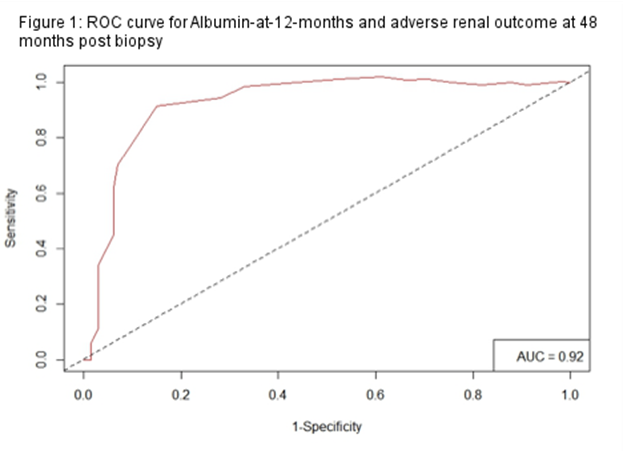Session Information
Date: Monday, November 6, 2017
Session Type: ACR Concurrent Abstract Session
Session Time: 2:30PM-4:00PM
Background/Purpose: LN is a common, deleterious manifestation of systemic lupus erythematosus (SLE) and despite recent advances in treatment remains the most significant end organ injury contributing to morbidity and mortality. Recent studies suggest at the 12-month mark post initial treatment, proteinuria <0.7g/day is predictive of favorable long term renal outcome. Using a large multi-ethnic SLE cohort, we assessed if the level of serum albumin and urine protein-to-creatinine ratio (uPCR) at 12-month mark was predictive of long-term renal outcome.
Methods: Data were obtained from the NYU SAMPLE biorepository/registry of 750 patients fulfilling SLE criteria, 249 with renal involvement. 83 met inclusion criteria of renal bx with at least 4 years of yearly f/u serum and urine data. Adverse renal outcome (ARO) was defined as doubling of creatinine (or final creatinine >4 if initial creatinine >2.5), ESRD or need for transplantation. Included patients had to be ARO free for the first year (±1 month). Spearman correlation coefficient(S) was estimated between albumin and uPCR at 12 months and Kaplan-Meier curves and Cox models used to evaluate the predictive role of each in ARO-free survival. ROC curves were constructed to generate optimal cutoff points for sensitivity and specificity (based on Youden indices) for albumin and uPCR at 12 months. P-values of ≤ 0.05, 2-side were considered statistically significant.
Results: Of the 83 subjects, 78% were female; median age 37.0±0.9, 10% white, 35% black, 14% Asian, 41% Hispanic. ISN/RPS Class represented: 42% V, 53% III&IV, 5% II. Median albumin and uPCR were 3.9 (Range: 2.1-4.9) and 0.86 (Range: 0.06-5.96). Albumin and uPCR values at 12 months were negatively correlated (S=-0.4, p=0.0002). There were 14 AROs in the 36 months follow-up period, with a 21% cumulative ARO rate. Univariate Cox models found albumin (hazard ratio (HR)=0.15) and uPCR at 12 months (HR=1.43) as significant predictors of ARO. When evaluated jointly, only albumin at 12 months was significant (HR=0.14). The ROC of albumin alone generated an area under the curve (AUC) of 0.92 with an optimal 12-month albumin cutoff of 3.7, predicting ARO-free at 48 months post-bx with a sensitivity of 91% and specificity of 85%.
Conclusion: Serum albumin at 1 year predicted ARO-free status with high sensitivity and specificity 4 years after induction treatment, outperforming uPCR. uPCR sensitivity and specificity in our analysis contrasts with other reports as the definition of ARO is more clinically relevant for avoiding renal replacement risk and has a shorter interval of follow-up. It remains to be determined if preservation of serum albumin, despite proteinuria, reflects a non-inflammatory state, if selectivity for non-albumin proteinuria represents less glomerular injury, or if non-albumin proteins are less injurious to the tubulointerstium.
To cite this abstract in AMA style:
Domingues V, Bornkamp N, Levinson BA, Goldberg JD, Buyon JP, Belmont HM. Serum Albumin at 12 Months Post Biopsy Has Excellent Sensitivity and Specificity for Favorable 4 Year Renal Outcome in Lupus Nephritis (LN) [abstract]. Arthritis Rheumatol. 2017; 69 (suppl 10). https://acrabstracts.org/abstract/serum-albumin-at-12-months-post-biopsy-has-excellent-sensitivity-and-specificity-for-favorable-4-year-renal-outcome-in-lupus-nephritis-ln/. Accessed .« Back to 2017 ACR/ARHP Annual Meeting
ACR Meeting Abstracts - https://acrabstracts.org/abstract/serum-albumin-at-12-months-post-biopsy-has-excellent-sensitivity-and-specificity-for-favorable-4-year-renal-outcome-in-lupus-nephritis-ln/

